Japanese Archaeology and Special Exhibition (Heiseikan) Japanese Archaeology Gallery
November 1, 2011 (Tue) - March 11, 2012 (Sun)
Many religious ceremony sites from the Kofun period (ca. 3rd–7th century) are in hard-to-reach places such as mountain passes, capes, or remote islands. These sites reveal how Japanese people at the time perceived divinity in nature and offered prayers in awe of gods.
Written materials from the Nara period, such as the Kojiki and the Nihon shoki chronicles, as well as official descriptions of regions, record how the malevolent deities who lived in these places were feared for obstructing people’s progress. The ceremony sites are considered to be where dedicatory objects were offered to appease these gods. These places are important as they reveal the form of rituals before they were codified by the genealogies of gods used in ceremonies connected to state unification, as recorded in Heian-period documents including the Engishiki set of laws.
Objects excavated from ceremony sites, predominantly hand-molded ceramics, changed characteristically over time. In the early Kofun period (4th century), these objects were mainly steatite stone models of items such as bronze mirrors, stone tools, beads and farming implements. In the mid-Kofun period (mid-5th century), in addition to smaller and more numerous steatite models, Sue pottery and clay models of mirrors, weapons, weaving equipment, brewing tools and other objects were also created for dedication. In the late Kofun period (6th century), many clay items also appeared in the shapes of jingle-bell mirrors, bells, farming tools, and figures of humans and horses. This diversification of dedicatory objects allows us to see how concepts of deities grew more varied over time.

